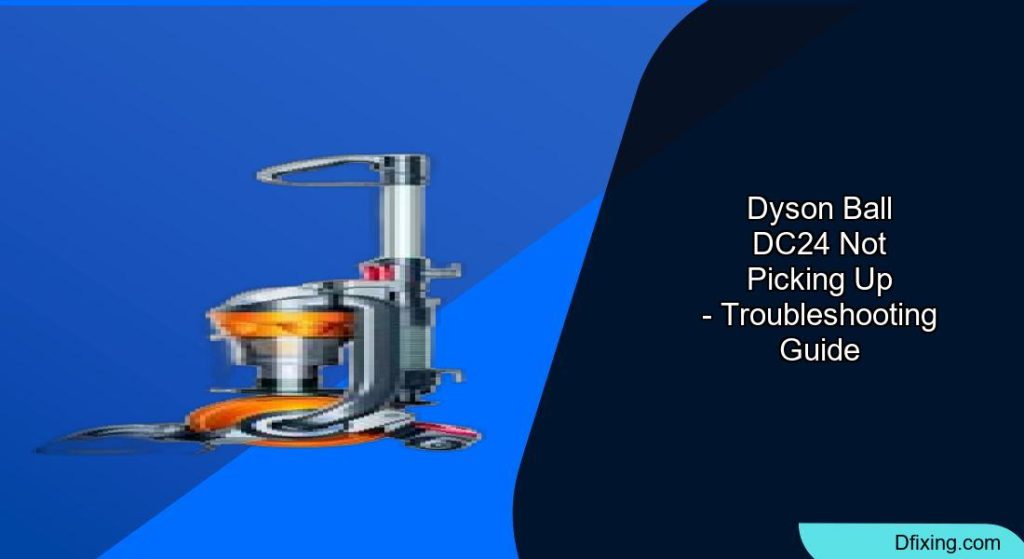The Dyson Ball DC24 is a powerful upright vacuum known for its maneuverability and strong suction capabilities. However, like any vacuum cleaner, it can develop issues over time that affect its performance. When your DC24 stops picking up debris effectively, it can be frustrating, but many common problems have straightforward solutions you can implement yourself.
Affiliate disclosure: As an Amazon associate, We'll earn a commission for every successful order through our affiliate links in the article. However, you won’t be charged anything for this.
This guide will walk you through comprehensive troubleshooting steps to restore your Dyson Ball DC24’s suction power. We’ll cover everything from basic maintenance tasks to more advanced solutions for persistent issues. Most suction problems can be resolved without professional help, saving you time and money while extending the life of your vacuum.
Common Causes of Poor Suction in Dyson DC24
The Dyson Ball DC24’s suction power can diminish for several reasons, and identifying the root cause is the first step toward fixing the issue. Here are the most common culprits behind a DC24 that’s not picking up properly:
Clogged Filters
The DC24 has washable filters that trap fine dust particles. When these filters become clogged, airflow is restricted, significantly reducing suction power. Many owners don’t realize how quickly filters can become saturated with dust.
Overfilled Dust Container
The transparent bin on your Dyson allows you to see when it’s full, but waiting until it reaches the “MAX” line can already impact performance. Emptying the bin regularly—even before it’s completely full—helps maintain optimal suction.
Blockages in the Airflow Path
Obstructions anywhere in the vacuum’s airflow pathway will reduce suction. This includes the hose, wand, cleaner head, and internal airways. Even small blockages can have a significant impact on performance.
Brush Roll Issues
If the brush roll (also called the brush bar) isn’t spinning properly due to tangled hair or debris, the vacuum won’t pick up effectively, especially on carpets. A worn-out brush roll can also reduce cleaning efficiency.
Damaged Seals or Hoses
Any air leaks in the system will compromise suction. Cracked hoses, damaged seals, or loose connections allow air to escape before it reaches the dust container.
Changeover Valve Problems
The DC24 uses a valve that switches suction between the floor head and the hose. If this valve is stuck or obstructed, suction may be directed to the wrong outlet.
Step-by-Step Troubleshooting Guide for Dyson DC24
Checking and Cleaning the Filters
- Power off and unplug your Dyson DC24 for safety.
- Locate the pre-motor filter (usually behind the dust bin) and the post-motor HEPA filter (typically on the ball or base of the machine).
- Remove both filters by following the release mechanisms specific to your model.
- Examine the filters for discoloration or visible dirt buildup.
- Wash the pre-motor filter under cold running water, gently squeezing until the water runs clear.
- Rinse the HEPA filter similarly, being careful not to damage the pleated material.
- Allow both filters to dry completely for at least 24 hours. Never reinstall damp filters as this can damage the motor and promote mold growth.
- Reinstall the dry filters securely in their proper positions.
- Replace filters that appear damaged or remain discolored after washing.
If your filters are damaged or discolored even after washing, it’s time to replace them to ensure optimal performance.
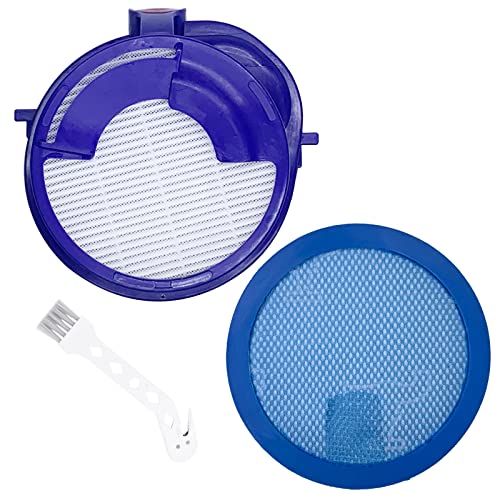
Includes HEPA post and washable pre-filter with cleaning brush
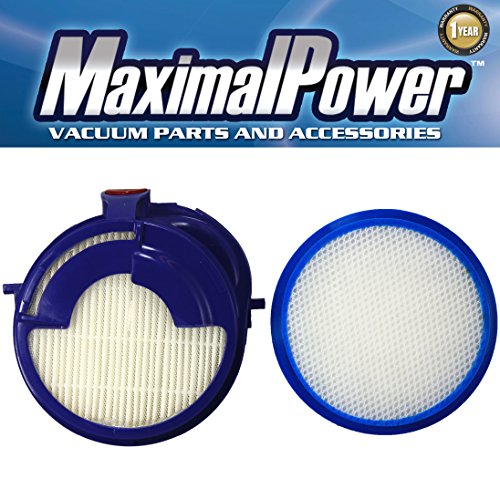
Durable washable filters with satisfaction guarantee

Comprehensive kit with premium cleaning performance
Emptying and Cleaning the Dust Container
- Press the bin release button to detach the dust container from the vacuum.
- Hold the container over a trash bin and press the release catch to empty the contents.
- Remove stubborn debris by hand if necessary (wearing gloves is recommended).
- Inspect the cyclone assembly for built-up dust or hair.
- Clean the cyclone unit by wiping it with a dry cloth or soft brush.
- For thorough cleaning, separate the cyclone from the bin (if your model allows) and wash the bin with water and mild soap.
- Ensure the bin is completely dry before reassembly.
- Check the rubber seals around the bin for damage or debris.
- Reattach the bin to the vacuum, making sure it clicks securely into place.
Inspecting and Clearing the Hose
- Detach the hose from both connection points.
- Visually inspect the entire length for blockages or damage.
- Run a broom handle or similar object through the hose to check for and dislodge obstructions.
- For visible blockages, use a long, flexible tool to carefully remove them.
- Check for splits or cracks in the hose material.
- Test flexibility by gently bending the hose – it should move freely without kinking.
- Examine connection points for damage or debris that might prevent a proper seal.
- Flush the hose with water if necessary to remove stubborn dirt (ensure it’s completely dry before reinstalling).
- Reconnect the hose firmly at both ends.
- Test suction through the hose with the vacuum running.
If you find cracks or splits in the hose, it’s time for a replacement to maintain optimal suction.
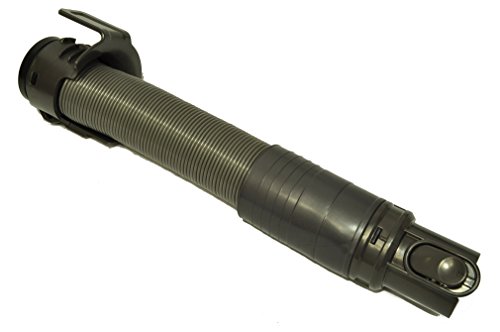
Official Dyson DC24 hose replacement for reliable suction and compatibility

Premium NSV replacement with reinforced build for enhanced durability
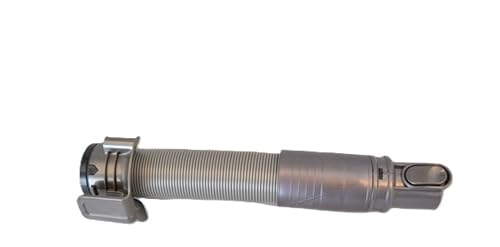
Budget-friendly 10′ hose with flexible polymer construction for easy maneuvering

OEM Dyson multi-model hose compatible with DC16-DC31 for trusted performance
Examining and Cleaning the Brush Roll
- Turn the vacuum upside down on a clean surface.
- Locate the brush bar access plate (usually secured with a coin-slot screw).
- Remove the access plate by turning the screw counterclockwise.
- Pull out the brush roll from its housing.
- Cut away tangled hair and fibers using scissors, working carefully along the length of the brush.
- Remove debris from the brush housing using a cloth or vacuum attachment.
- Check the brush roll bearings at each end for smooth rotation.
- Inspect the drive belt for wear, cracks, or looseness (if your model has an exposed belt).
- Examine the brush bristles for wear – if significantly worn down, the brush roll should be replaced.
- Reinstall the brush roll, ensuring it seats properly in the housing.
- Replace the access plate and secure with the screw.
- Test the brush roll by turning on the vacuum and observing if it spins freely.
Checking the Changeover Valve
- Locate the changeover valve at the back of the machine near the bottom.
- Inspect the valve mechanism for any visible obstructions or damage.
- Manually operate the valve by switching between floor and hose modes several times.
- Listen for clicking sounds that indicate proper movement.
- Remove any debris that might be preventing smooth operation.
- Test suction in both positions to ensure the valve is directing airflow correctly.
- If the valve seems stuck, a small amount of silicone lubricant can be applied (avoid petroleum-based products).
- For persistent valve issues, disassembly may be required – consult your user manual for specific instructions.
Inspecting Internal Connections
- Lay the vacuum on its front to access the underside.
- Remove the cleaner head by pressing the release button and pulling it away.
- Examine the internal hose connection where the cleaner head attaches.
- Check for loose connections or debris preventing a proper seal.
- Turn the machine over with the bin facing upward.
- Place your hand over the opening where the cleaner head connects.
- Turn on the vacuum to test suction at this point.
- If suction is strong here but weak at the cleaner head, the internal hose may be disconnected.
- Reattach any loose connections firmly.
- Reassemble the cleaner head, ensuring it clicks securely into place.
Checking Motor Performance
- Listen to the motor when the vacuum is running – it should produce a consistent sound.
- Be alert for unusual noises such as grinding, whining, or intermittent operation.
- Check for burning smells which could indicate motor overheating.
- Ensure proper airflow around the motor housing.
- Verify the vacuum isn’t overheating during use.
- Allow a hot vacuum to cool completely before attempting further troubleshooting.
- Check the power cord for damage that might affect electricity supply.
- Test the vacuum in different outlets to rule out power supply issues.
- For persistent motor problems, professional service may be required.
Maintenance Tips to Prevent Future Suction Problems
Regular Cleaning Schedule
- Empty the dust bin after each use or when it reaches the halfway mark.
- Wash pre-motor filters every month under cold water.
- Clean the HEPA filter every three months.
- Inspect the brush roll weekly for hair and thread buildup.
- Check hoses for blockages monthly.
- Wipe down the exterior and cyclone assembly regularly to prevent dust buildup.
- Clean the ball assembly periodically to maintain smooth movement.
- Inspect seals and gaskets quarterly for wear or damage.
Proper Usage Techniques
- Avoid vacuuming wet substances which can damage the motor and promote mold growth.
- Don’t pick up fine particles like drywall dust or fireplace ash without a proper filter.
- Use appropriate power settings for different floor types.
- Move the vacuum slowly over carpets to allow proper dirt extraction.
- Switch to hose mode for above-floor cleaning rather than tilting the entire vacuum.
- Store the vacuum in an upright position in a dry location.
- Wind the cord properly after use to prevent damage.
- Use appropriate attachments for different cleaning tasks.
Frequently Asked Questions (FAQ)
Why does my Dyson DC24 keep cutting out during use?
This typically indicates overheating protection has activated. The most common causes are blocked filters or airways restricting airflow. Clean all filters, check for blockages, and allow the vacuum to cool completely before restarting. If the problem persists, the thermal cut-out switch may be faulty and require professional repair.
How often should I replace the filters on my Dyson DC24?
With proper maintenance, Dyson filters can last several years. However, if you notice the filters remain discolored after washing or develop tears, it’s time to replace them. As a general guideline, consider replacing filters every 1-2 years with regular use. Households with pets or allergies may need more frequent replacements.
My Dyson DC24 makes a high-pitched noise. What’s wrong?
A high-pitched noise often indicates an obstruction somewhere in the airflow path. Check the hose, wand, and brush bar for blockages. It could also signal a bearing issue in the brush roll or motor. If the noise persists after clearing all potential blockages, the motor bearings may be wearing out, requiring professional service.
Can I use my Dyson DC24 without filters while they’re drying?
Never operate your Dyson without all filters properly installed. Running the vacuum without filters can allow dust and debris to enter the motor, causing permanent damage. Always have a spare set of filters on hand so you can continue using your vacuum while the freshly washed set dries completely.
To ensure you can always use your vacuum, keep an extra set of filters on hand.
Search term for Amazon: Dyson DC24 Filter Set
Why is my Dyson brush bar not spinning even though the vacuum is on?
Several issues could prevent the brush bar from spinning: hair and debris tangled around the brush, a worn or broken drive belt, a faulty brush bar motor, or activation of the safety cut-out feature. First, check for and remove any obstructions. If the brush bar still doesn’t spin, inspect the drive belt (if visible) or reset the safety cut-out button typically located near the brush bar housing.
Conclusion
A Dyson Ball DC24 that’s not picking up properly can usually be restored to full functionality through systematic troubleshooting and regular maintenance. By following the comprehensive steps outlined in this guide, you can identify and resolve most suction problems without professional help.
Remember that prevention is the best approach—establish a regular cleaning schedule for your vacuum components, especially the filters and dust bin. This proactive maintenance will not only ensure consistent performance but also extend the lifespan of your Dyson DC24.
If you’ve tried all the suggested solutions and your vacuum still isn’t performing properly, it may be time to contact Dyson customer support or visit an authorized service center. With proper care and timely intervention, your Dyson Ball DC24 can continue to provide powerful cleaning performance for many years.

